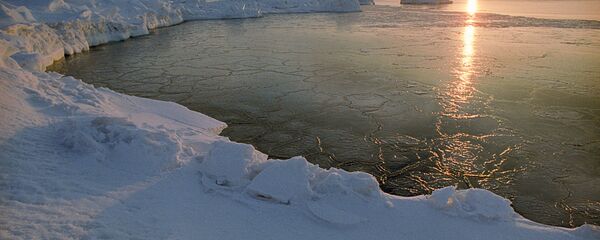Russia and Denmark could partition the Lomonosov Ridge, an underwater mountain range, which runs across the North Pole that splits the Arctic in two, if a UN Commission on the Limits of the Continental Shelf (CLCS) allows them to expand their continental shelves northward, Leopold Lobkovsky, deputy director of the Institute of Oceanic Studies in Moscow, told Radio Sputnik.
“The Lomonosov Ridge connects our continental shelf with Denmark’s, that’s why we can extend and they can extend. If our claims are approved Russia and Denmark could carve it up somewhere around the North Pole,” Lobkovsky said.
In early August 2015, Russia submitted a partially revised application to the United Nations seeking to enlarge its continental shelf limits in the Arctic Ocean. The application included Russia’s scientifically substantiated claim for expanding the shelf area in the Murmansk-North Pole-Chukotka triangle.
In keeping with the UN Convention on the Law of the Sea, a country wishing to expand its shelf needs to prove that the underwater features adjacent to it are natural geological extensions of the country’s continental shelf.
A coastal state can always claim its rights to the shelf within the distance of 200 nautical miles from the coastline.
In an interview with Radio Sputnik, political analyst Alexei Gusev said that other countries could also demand their share of the Arctic Ocean. These countries are Canada, the US, Norway, Iceland, Sweden and Finland.
Gusev believes, however, that the Russian and Danish claims are more preferable.
"Why? Because the Lomonosov Ridge runs from Russia via the North Pole to Greenland, which is Danish territory. We and Denmark could settle this issue between us as part of the proposed division of the Lomonosov Ridge. They haven’t responded yet, arguing that it’s up the UN commission to decide,” Gusev noted.
He added that because the Arctic seabed is believed to hold up to 22 percent of the global resources of oil and gas he expected a tough fight ahead.
“I think that it won’t be long before major plays join in the fray. China’s for one, has already said that it has its own interests in the Arctic, so I think it’s going to be a tough battle,” Alexei Gusev warned.
On December 20, 2001, Russia sent an application to the CLCS to expand its Arctic shelf beyond the 200-mile area, which means the right to include the underwater space near the northern coast (contiguous to the Arctic Ocean) and the eastern coast (contiguous to the Pacific Ocean) in its continental shelf.
Russia’s current, partially revised application is corroborated by the results of a 10-year complex geological and geophysical research conducted in the Arctic water area, including full-scale expeditions engaging ice-breakers and special research vessels.
Never miss a story again — sign up to our Telegram channel and we'll keep you up to speed!






